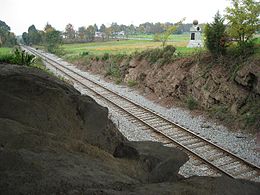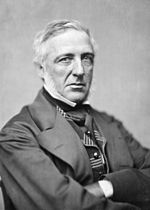
The Battle of Gettysburg was a three-day battle in the American Civil War fought between Union and Confederate forces between July 1 and July 3, 1863, in and around Gettysburg, Pennsylvania. The battle, which was won by the Union, is widely considered the Civil War's turning point, ending the Confederacy's aspirations to establish an independent nation. It was the Civil War's bloodiest battle, claiming over 50,000 combined casualties over three days.
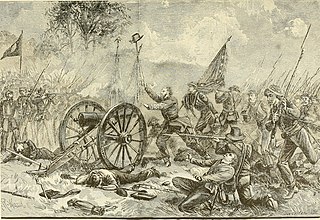
Pickett's Charge, also known as the Pickett–Pettigrew–Trimble Charge, was an infantry assault ordered by Confederate General Robert E. Lee against Major General George G. Meade's Union positions on the last day of the Battle of Gettysburg in Pennsylvania during the Civil War. Confederate troops made a frontal assault toward the center of Union lines, ultimately being repulsed with heavy casualties. Suffering from a lack of preparation and problems from the onset, the attack was a costly mistake that decisively ended Lee's invasion of the north and forced a retreat back to Virginia.

Lysander Cutler was an American businessman, educator, politician, and Union Army General during the American Civil War.

The Second Battle of Winchester was fought between June 13 and June 15, 1863, in Frederick County and Winchester, Virginia as part of the Gettysburg Campaign during the American Civil War. As Confederate Lieutenant General Richard S. Ewell moved north through the Shenandoah Valley in the direction of Pennsylvania, his corps defeated the Union Army garrison commanded by Major General Robert H. Milroy, capturing Winchester and numerous Union prisoners.

Culp's Hill, which is about 3⁄4 mi (1,200 m) south of the center of Gettysburg, Pennsylvania, played a prominent role in the Battle of Gettysburg. It consists of two rounded peaks, separated by a narrow saddle. Its heavily wooded higher peak is 630 ft (190 m) above sea level. The lower peak is about 100 feet shorter than its companion. The eastern slope descends to Rock Creek, about 160 feet lower in elevation, and the western slope is to a saddle with Stevens Knoll with a summit 100 ft (30 m) lower than the main Culp's Hill summit. The hill was owned in 1863 by farmer Henry Culp and was publicized as "Culp's Hill" by October 31, 1865.

The Gettysburg campaign was a military invasion of Pennsylvania by the main Confederate army under General Robert E. Lee in summer 1863. It was the first time during the war the Confederate Army attempted a full-scale invasion of a free state. The Union won a decisive victory at Gettysburg, July 1–3, with heavy casualties on both sides. Lee managed to escape back to Virginia with most of his army. It was a turning point in the American Civil War, with Lee increasingly pushed back toward Richmond until his surrender in April 1865. The Union Army of the Potomac was commanded by Maj. Gen. Joseph Hooker and then by Maj. Gen. George G. Meade.

The first day of the Battle of Gettysburg during the American Civil War took place on July 1, 1863, and began as an engagement between isolated units of the Army of Northern Virginia under Confederate General Robert E. Lee and the Army of the Potomac under Union Maj. Gen. George G. Meade. It soon escalated into a major battle which culminated in the outnumbered and defeated Union forces retreating to the high ground south of Gettysburg, Pennsylvania.
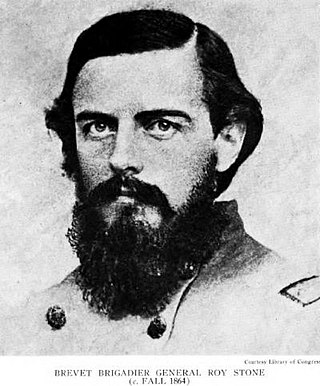
Roy Stone was an American soldier, civil engineer, and inventor. He served in the American Civil War, distinguishing himself during the Battle of Gettysburg, and took part in the Spanish–American War. He pursued a civil engineering career in a peacetime and became in 1893 the first head of the Office of Road Inquiry, which was the Federal Highway Administration's predecessor.

John Lawrence Burns was an American soldier and constable. A veteran of the War of 1812, at age 69 he fought as a civilian combatant with the Union Army at the Battle of Gettysburg during the American Civil War. He was wounded, but survived to become a national celebrity.

The 6th Wisconsin Infantry Regiment was an infantry regiment that served in the Union Army during the American Civil War. It spent most of the war as a part of the famous Iron Brigade in the Army of the Potomac.

The 8th Illinois Cavalry Regiment was a cavalry regiment that served in the Union Army during the American Civil War. The regiment served the duration of the war, and was the only Illinois cavalry regiment to serve the entire war in the Army of the Potomac. They also aided in the hunt for John Wilkes Booth and served as President Lincoln's honor guard while he lay in state under the rotunda. Lincoln gave them the nickname of "Farnsworth's Abolitionist Regiment" when he watched them march past the White House.

The 22nd Regiment Massachusetts Volunteer Infantry was an infantry regiment in the Union army during the American Civil War. The 22nd Massachusetts was organized by Senator Henry Wilson and was therefore known as "Henry Wilson's Regiment." It was formed in Boston, Massachusetts, and established on September 28, 1861, for a term of three years.

The 151st Pennsylvania Infantry was a Union Army regiment serving for a term of nine months during the American Civil War. The regiment sustained seventy-six percent casualties in the Battle of Gettysburg, its only major engagement.

The Confederate Army of Northern Virginia began its Retreat from Gettysburg on July 4, 1863. Following General Robert E. Lee's failure to defeat the Union Army at the Battle of Gettysburg, he ordered a retreat through Maryland and over the Potomac River to relative safety in Virginia. The Union Army of the Potomac, commanded by Maj. Gen. George G. Meade, was unable to maneuver quickly enough to launch a significant attack on the Confederates, who crossed the river on the night of July 13 into South Mountain through Cashtown in a wagon train that extended for 15–20 miles, enduring harsh weather, treacherous roads, and enemy cavalry raids. The bulk of Lee's infantry departed through Fairfield and through the Monterey Pass toward Hagerstown, Maryland. Reaching the Potomac, they found that rising waters and destroyed pontoon bridges prevented their immediate crossing. Erecting substantial defensive works, they awaited the arrival of the Union army, which had been pursuing over longer roads more to the south of Lee's route. Before Meade could perform adequate reconnaissance and attack the Confederate fortifications, Lee's army escaped across fords and a hastily rebuilt bridge.
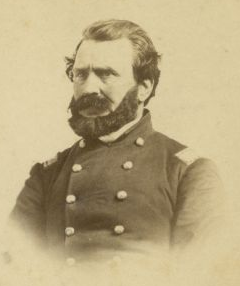
William Wallace Robinson, Sr., was a Union Army officer and American diplomat. He commanded the 7th Wisconsin Infantry Regiment in the famed Iron Brigade of the Army of the Potomac through most of the Civil War, and was U.S. consul to the Merina Kingdom of Madagascar for 12 years (1875–1887).
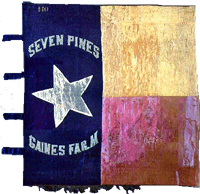
The 1st Texas Infantry Regiment, nicknamed the "Ragged Old First," was an infantry regiment raised in Texas for service in the Confederate States Army during the American Civil War. It fought mostly with the Army of Northern Virginia.

McPherson Ridge is a landform used for military engagements during the 1863 Battle of Gettysburg, when the I Corps of the Union Army had a headquarters on the ridge and was defeated by the Confederate division of Major General Henry Heth. The ridge has terrain above ~530 ft (160 m) and is almost entirely a federally protected area except for township portions at the southern end and along Pennsylvania Route 116, including a PennDOT facility. The northern end is a slight topographic saddle point on the west edge of Oak Ridge, and summit areas above 560 ft (170 m) include 4 on/near the Lincoln Highway, a broader summit south of the Fairfield Road, and the larger plateau at the northern saddle.

The 149th Pennsylvania Infantry, also known as the 2nd Bucktail Regiment, volunteered during the American Civil War and served a 3-year term from August 1862 to June 1865. Like their forerunners in the 1st Bucktail Regiment, each soldier wore a bucktail on his headwear as a trophy of marksmanship.
During the first year of the Civil War, the 1st Bucktails distinguished themselves as skirmishers and sharpshooters, and Secretary of War Edwin M. Stanton desired to raise an entire brigade of similar characteristics. Stanton enlisted Major Roy Stone of the 1st Bucktails to this task, and Stone raised 20 companies of recruits by the end of August 1862. These 20 companies became the 149th and 150th Pennsylvania Infantry Regiments.
The Regiment is most noted for its service and sacrifice on July 1, 1863, at the Battle of Gettysburg. One source reports 53 soldiers killed, 172 wounded, and 111 missing or captured out of 450 soldiers engaged for a total casualty rate of 74.7% at the epic Battle.

The Battle of Fairfax Court House was fought during the Gettysburg Campaign of the American Civil War between two cavalry detachments from the Union Army of the Potomac, commanded by General Joseph Hooker, and the Confederate Army of Northern Virginia, commanded by General Robert E. Lee.

The 2nd Mississippi Infantry Regiment was a unit of the Confederate States Army during the American Civil War. The 2nd Regiment was composed of volunteer companies from North Mississippi which were sent to join the Confederate forces in Virginia in the spring of 1861. As part of the Army of Northern Virginia, the 2nd Regiment fought in many of the most decisive battles of the Eastern theater of the American Civil War, suffering heavy casualties at Antietam and Gettysburg.

